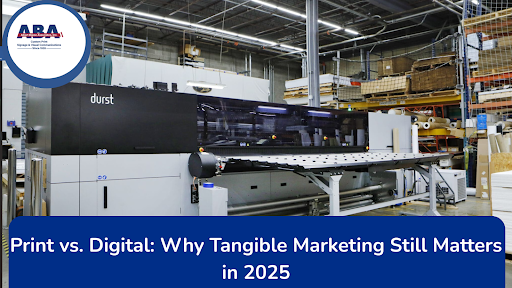Print vs. Digital: Why Tangible Marketing Still Matters in 2025

- Despite the dominance of digital marketing, tangible print materials remain vital in 2025 for building trust, credibility, and deeper sensory engagement with audiences.
- Print overcomes digital limitations like oversaturation, fleeting engagement, and ad fatigue by offering permanence, memorability, and a distraction-free brand experience.
- Businesses can achieve stronger marketing results by integrating high-quality print solutions with digital campaigns—an approach Albert Basse Associates specializes in delivering.
In an era dominated by smartphones, social media, and digital advertising, it’s easy to assume that print marketing has become obsolete. However, in 2025, print continues to prove its relevance as a powerful, trustworthy, and impactful marketing tool. The ongoing debate of print versus digital is not about choosing one over the other, but understanding the value that each medium brings to the marketing ecosystem.
Let’s explore why tangible marketing remains essential, how it complements digital efforts, and why brands that leverage both can achieve better results.
The Enduring Power of Print in a Digital World
Despite rapid advancements in digital marketing technologies, print holds an enduring place in modern marketing strategies. There’s something inherently impactful about holding a well-designed brochure, flipping through the pages of a magazine, or receiving a thoughtfully crafted direct mail piece. Tangibility evokes a sensory connection that digital screens simply cannot replicate.
Print materials offer physical presence, permanence, and credibility. Consumers often perceive printed materials as more trustworthy than digital ads, which can easily be lost in the noise of pop-ups, banners, and sponsored posts. This trust factor is particularly crucial for industries like finance, healthcare, and education, where credibility is paramount.
Moreover, printed materials have an unmatched ability to engage multiple senses. The feel of high-quality paper, the scent of freshly printed materials, and the visual impact of sharp graphics all combine to create memorable brand experiences. These sensory interactions significantly boost brand recall, making print an indispensable marketing asset—especially when produced with advanced digital printing technology that delivers superior precision and consistency.
Print as a Trustworthy Medium
One of the most compelling advantages of print is its inherent trust factor. Audiences often regard printed materials as more credible and serious compared to digital formats. A printed brochure, catalog, or report signals a level of professionalism and commitment that fleeting digital ads cannot always convey. In industries where trust, transparency, and reliability are essential—such as healthcare, financial services, or legal sectors—print provides a level of assurance that enhances brand reputation.
The Longevity of Print Materials
Unlike digital content that can disappear with the click of a button, printed materials have a physical presence that extends their lifecycle. A well-designed magazine, direct mail piece, or corporate brochure can remain in offices, homes, or reception areas for weeks, months, or even years. This constant visibility reinforces brand awareness long after a digital ad has vanished from a screen. The longevity of print ensures that messaging has a lasting impact, making it a strategic investment for marketers seeking durable brand impressions.
The Tangible Sensory Experience
The sensory engagement offered by print sets it apart from purely visual digital formats. The texture of premium paper, the weight of a high-quality business card, or the vibrant colors of a professionally printed poster—created through precise digital printing—all stimulate the senses in ways that digital media cannot replicate. This multisensory interaction creates a deeper, more memorable connection with the audience, making brand messaging more likely to be remembered and appreciated.
Print in a Distracted Digital Landscape
The modern digital landscape is saturated with constant notifications, pop-ups, and an overwhelming flow of information. Amidst this digital noise, print offers a moment of pause. Receiving a physical mailer, reading a magazine, or browsing a product catalog invites focused attention without competing against other tabs, apps, or social feeds. Print allows brands to engage with consumers in a less distracted environment, increasing the likelihood of message retention and meaningful engagement.
Print also holds cultural and psychological value that digital formats often lack. Historically, printed materials like newspapers, magazines, and books have been viewed as reliable sources of information. This legacy continues to influence how audiences perceive printed marketing—as credible, considered, and intentional.
Another advantage of print lies in its ability to reach audiences in spaces where digital messages struggle to penetrate. Waiting rooms, reception areas, conferences, retail environments, and even homes often feature printed materials that attract undivided attention. Unlike digital content, which competes for milliseconds of engagement, print commands focus and invites deliberate interaction.
Additionally, print is less susceptible to the volatility of algorithms and platform changes. Brands relying solely on digital advertising can see their reach dramatically shift overnight due to social media platform updates or privacy regulation changes. Print, on the other hand, provides a stable, consistent means of connecting with audiences, unaffected by digital disruptions.
In an age where marketing is increasingly automated and impersonal, print offers a tactile, authentic alternative. Its physical nature reinforces a brand’s presence in the real world, making it a lasting, impactful component of a well-rounded marketing strategy.
Digital Dominance and Its Limitations
Digital marketing undeniably offers speed, scalability, and data-driven precision. Businesses can reach global audiences almost instantly, track real-time performance, and tailor campaigns with unprecedented accuracy. The ability to conduct A/B testing, adjust campaigns on the fly, and target hyper-specific demographics makes digital marketing a powerful tool in any marketer’s arsenal.
However, digital marketing also faces significant limitations.
Oversaturation and Digital Fatigue
One of the most pressing challenges is oversaturation. Consumers are inundated with thousands of digital messages daily, from social media notifications to email promotions and pop-up ads. This constant exposure leads to digital fatigue, where users become desensitized to online content or actively avoid it altogether. As audiences grow more selective in their digital interactions, brands face increasing difficulty in standing out and retaining attention.
The Rise of Ad-Blocking and Privacy Concerns
The widespread use of ad-blocking software presents another hurdle for digital marketers. A growing percentage of internet users install ad blockers to escape intrusive or irrelevant ads, significantly reducing the potential reach of online campaigns. Simultaneously, heightened concerns around data privacy—fueled by high-profile data breaches and evolving regulations like GDPR and CCPA—have made consumers wary of sharing personal information online. This environment limits the effectiveness of digital personalization strategies and erodes trust in digital platforms.
Fleeting Engagement and Lack of Permanence
Digital content often suffers from fleeting engagement. Users quickly scroll past social media posts, emails get deleted without being opened, and websites are abandoned within seconds. Unlike tangible materials that linger on desks or countertops, digital messages frequently disappear as quickly as they appear, making it harder for brands to establish lasting impressions or meaningful connections.
Algorithm Dependence and Platform Instability
Digital marketing success is heavily reliant on the algorithms of platforms like Google, Facebook, and Instagram—which are frequently updated and beyond a brand’s control. These algorithm shifts can instantly alter a campaign’s visibility, engagement rates, or return on investment. Over-reliance on a few major platforms creates vulnerability, forcing marketers to constantly adapt to unpredictable changes that disrupt consistency in outreach efforts.
Digital Burnout and the Need for Offline Experiences
An increasing number of consumers are seeking to limit their screen time to reduce stress and improve well-being, a phenomenon known as digital burnout. This creates a gap in reaching audiences who consciously disconnect from digital platforms. In these moments, tangible marketing—through print materials, direct mail, or physical brand experiences—provides a non-intrusive, trusted alternative for maintaining brand visibility and engagement.
While digital tools offer impressive benefits, these limitations highlight the importance of diversifying marketing channels. Tangible marketing, particularly print, provides stability, credibility, and physical presence, complementing digital efforts and ensuring that brands maintain connections with audiences across both digital and real-world spaces.
Why Tangible Marketing Still Matters in 2025

The relevance of tangible marketing in 2025 is rooted in its ability to cut through digital clutter, establish brand credibility, and forge deeper connections with audiences. As consumers crave authenticity and meaningful engagement, print provides a trusted channel to meet those expectations.
Print campaigns demonstrate intentionality. Unlike fleeting digital ads, printed materials require thoughtful design, precise messaging, and strategic distribution—made possible with modern digital printing capabilities. This investment signals to customers that a brand values quality and attention to detail, fostering stronger emotional connections.
Furthermore, tangible marketing excels at targeting specific demographics, particularly in localized or niche markets. Direct mail campaigns, event signage, product packaging, and promotional materials create lasting impressions within communities and specialized industries. For B2B sectors, high-quality printed collateral such as catalogs, brochures, and corporate reports remain integral to building professional relationships.
In an increasingly digital society, physical materials provide a welcome sense of permanence. A well-crafted print piece can sit on a desk, coffee table, or reception area, offering ongoing brand visibility long after a digital ad has disappeared.
How Print and Digital Marketing Complement Each Other
The most successful marketing strategies in 2025 are not defined by choosing between print or digital, but by integrating both to maximize impact. Print and digital channels complement each other, creating a cohesive, multi-touchpoint customer experience.
For example, printed materials can drive digital engagement by incorporating QR codes, personalized URLs, or augmented reality features that connect audiences to online platforms. A direct mail piece with a QR code can lead recipients to an interactive landing page, blending the tangible and digital seamlessly.
Conversely, digital campaigns can amplify the reach and relevance of print. Email newsletters, social media posts, and targeted ads can promote upcoming print campaigns, ensuring audiences are primed to engage with tangible materials. When print and digital efforts align, they reinforce brand messaging, increase conversions, and build stronger brand recognition.
This integrated approach also provides marketers with valuable data insights. Digital tools can track interactions initiated by print materials, offering a clearer picture of customer behavior and campaign effectiveness. The synergy between print and digital ultimately drives better ROI and elevates overall marketing performance.
The Psychological Impact of Print
Numerous studies highlight the unique psychological impact of print marketing. Research indicates that printed materials are more likely to be remembered and trusted compared to digital content. When individuals engage with physical materials, they process information more deeply, leading to better comprehension and recall.
The tactile nature of print stimulates the brain differently than digital screens. Holding a brochure, turning pages, or unfolding a mailer engages motor skills and sensory receptors, creating a multisensory experience. This heightened engagement enhances message retention, making print an ideal medium for conveying complex information, storytelling, or emotional appeals.
Printed materials also create a sense of ownership and personal connection. Receiving a beautifully designed direct mail piece or product catalog fosters a feeling of exclusivity and importance, encouraging recipients to engage with the content more thoroughly than they might with digital messages.
Psychologically, print appeals to a slower, more reflective form of engagement. Unlike the rapid-fire consumption of online content, print invites readers to take their time, absorb information, and reflect on brand messaging. This slower pace aligns with cognitive patterns that enhance memory retention and emotional resonance.
Additionally, the permanence of print lends itself to trust and authority. Consumers perceive tangible materials as more reliable, reinforcing the credibility of brands, especially in sectors where trust is critical—such as healthcare, financial services, or education. Printed content avoids the fleeting, disposable nature often associated with digital ads, instead positioning the brand as thoughtful, established, and invested in quality communication.
In a fast-paced, distraction-heavy world, the psychological benefits of print—from increased focus and memory retention to emotional connection—make it a vital tool for building lasting, impactful relationships with audiences.
Sustainable Innovations in Print Marketing
A common misconception is that print marketing negatively impacts the environment. However, advancements in sustainable printing technologies have significantly reduced the ecological footprint of tangible marketing.
In 2025, many print providers prioritize eco-friendly practices, including using recycled paper, vegetable-based inks, and energy-efficient production methods. Certifications such as FSC (Forest Stewardship Council) or SFI (Sustainable Forestry Initiative) ensure that materials originate from responsibly managed sources.
Additionally, print marketing often involves targeted, strategic distribution, minimizing waste and maximizing relevance. Brands can leverage data insights to send personalized, meaningful print materials to specific audiences, reducing unnecessary production.
Sustainable print initiatives align with growing consumer demand for environmentally conscious practices, allowing businesses to demonstrate their commitment to both effective marketing and corporate social responsibility.
How Albert Basse Associates Elevates Tangible Marketing
For over a century, our experts at Albert Basse Associates have been at the forefront of delivering exceptional print solutions that help brands stand out. As a trusted leader in the print industry, we understand the evolving landscape of marketing and the enduring value of tangible materials.
Our state-of-the-art digital printing services combine innovation, speed, and precision—empowering businesses to produce high-quality print materials with striking detail, vibrant colors, and consistent results. Whether you need brochures, signage, custom packaging, or promotional materials, we ensure every project reflects your brand’s vision with outstanding quality.
We also bridge the gap between print and digital through innovative solutions that integrate QR codes, personalized messaging, and data-driven targeting. Our comprehensive approach helps businesses enhance brand visibility, foster meaningful connections, and achieve measurable marketing success.
As marketing continues to evolve, we remain dedicated to helping businesses leverage the power of print—supported by cutting-edge digital printing technology—in harmony with digital strategies. Our expertise ensures that tangible marketing not only survives but thrives in 2025 and beyond.
Ready to elevate your brand with high-quality digital printing and tangible marketing solutions? Partner with us at Albert Basse Associates, Inc. and discover how tangible marketing can drive real results for your business. Contact us today to get started.
